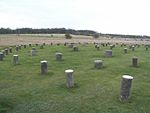Amesbury Priory
Amesbury Priory was a Benedictine monastery at Amesbury in Wiltshire, England, belonging to the Order of Fontevraud. It was founded in 1177 to replace the earlier Amesbury Abbey, a Saxon foundation established about the year 979. The Anglo-Norman Amesbury Priory was disbanded at the Dissolution of the monasteries and ceased to exist as a monastic house in 1539.While the earlier Amesbury Abbey had been exclusively a nunnery or house of women, its successor, Amesbury Priory, following the particular structures of its parent Order of Fontevraud, was both a convent of nuns and a corresponding monastery of men. Both were governed locally by a prioress and ultimately by the Abbess of Fontevraud, in Anjou, part of the territories in what is now France that were then ruled by the English royal house. Nothing remains of the priory above ground, its site having been used for a mansion which re-uses the name Amesbury Abbey.
Excerpt from the Wikipedia article Amesbury Priory (License: CC BY-SA 3.0, Authors).Amesbury Priory
Church Lane,
Geographical coordinates (GPS) Address Nearby Places Show on map
Geographical coordinates (GPS)
| Latitude | Longitude |
|---|---|
| N 51.174 ° | E -1.784 ° |
Address
Church Lane
SP4 7HA , Amesbury
England, United Kingdom
Open on Google Maps









